1995 CHEVROLET S10 tow
[x] Cancel search: towPage 11 of 354
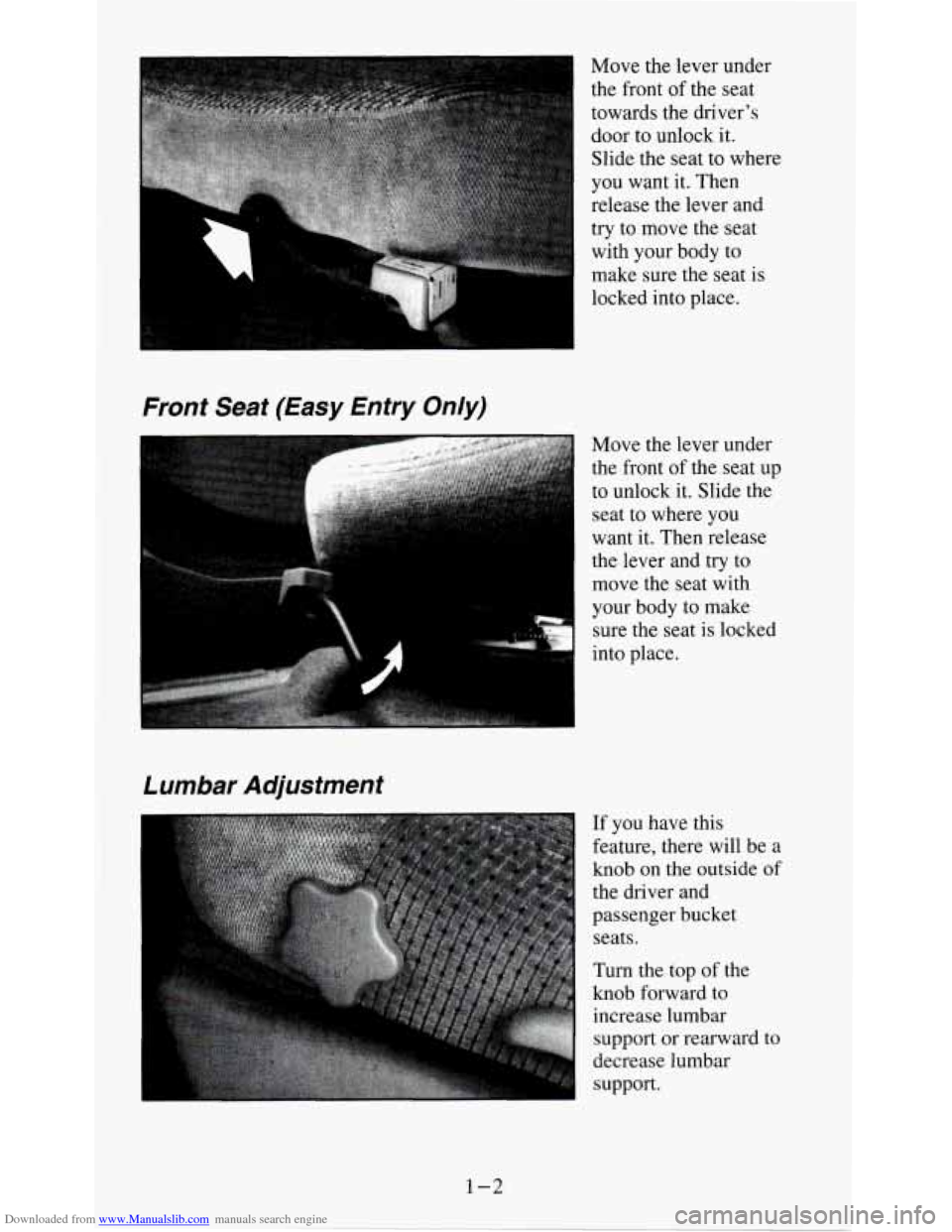
Downloaded from www.Manualslib.com manuals search engine r
Move the lever under
the front
of the seat
towards the driver’s door to unlock it.
Slide the seat to where
you want it. Then
release the lever and
try to move the seat
with your body to
make sure the seat is
locked into place.
Front Seat (Easy Entry Only)
Move the lever under
the front
of the seat up
to unlock it. Slide the
seat to where you
want it. Then release
the lever and
try to
move the seat with
your body to make
7 sure the seat is locked
into place.
If you have this
feature, there will be a
knob
on the outside of
the driver and
passenger bucket seats.
Turn the top of the
knob forward to
increase
lumbar
support or rearward to
decrease lumbar
support.
1-2
Page 13 of 354
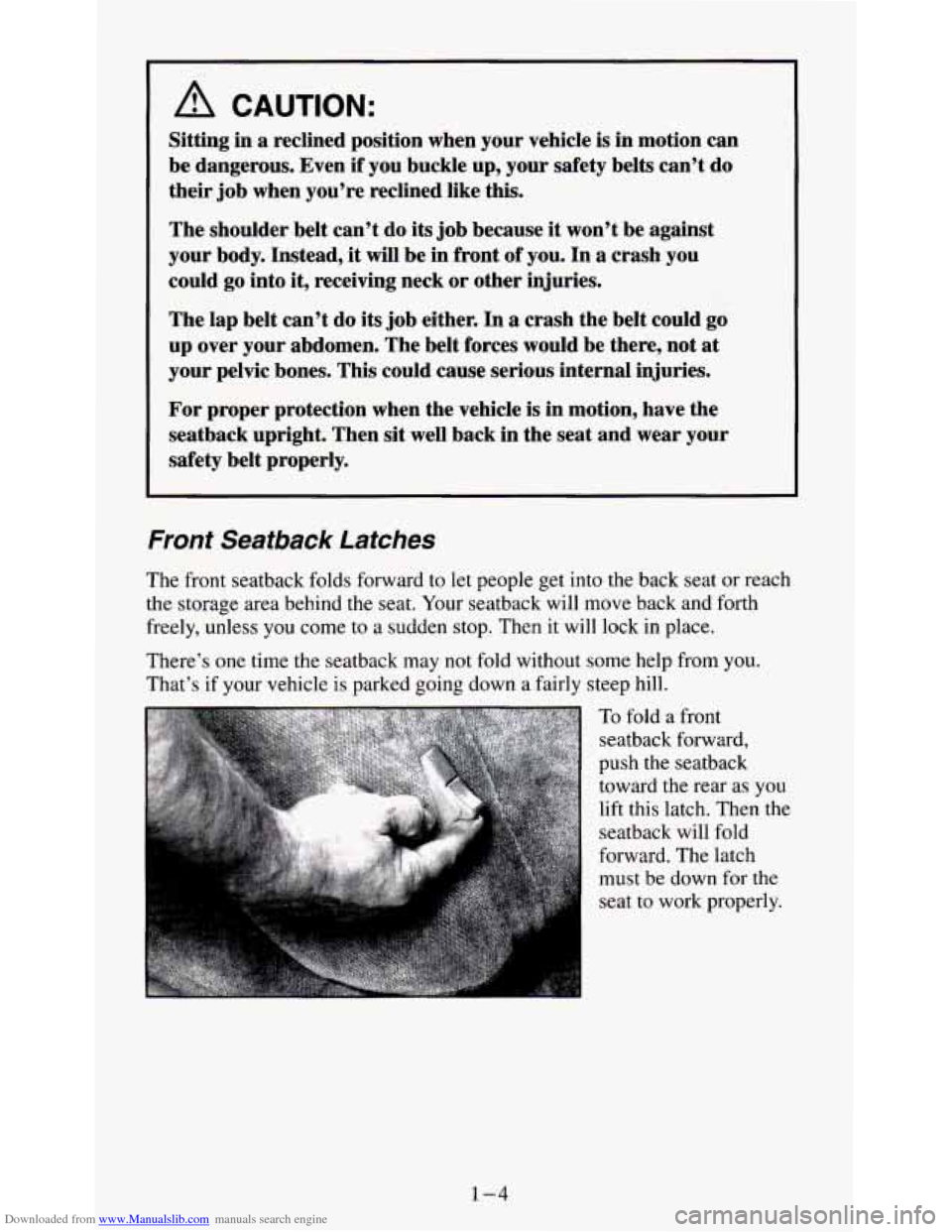
Downloaded from www.Manualslib.com manuals search engine A CAUTION:
Sitting in a reclined position when your vehicle is in motion can
be dangerous. Even if you buckle up, your safety belts can’t do
their job when you’re reclined like this.
The shoulder belt can’t
do its job because it won’t be against
your body. Instead, it will be in front of you. In a crash
you
could go into it, receiving neck or other injuries.
The lap belt can’t do its job either. In a crash the belt could
go
up over your abdomen. The belt forces would be there, not at
your pelvic bones. This could cause serious internal injuries.
For proper protection when the vehicle is in motion, have the
seatback upright. Then sit well back in the seat and wear your
safety belt properly.
Front Seatback Latches
The front seatback folds forward to let people get into the back seat or reach
the storage area behind the seat. Your seatback will move back and forth
freely, unless you come to a sudden stop. Then it
will lock in place.
There’s
one time the seatback may not fold without some help from you.
That’s if your vehicle
is parked going down a fairly steep hill.
To fold a front
seatback forward,
push the seatback
toward the rear
as you
lift this latch. Then the
seatback will fold
forward. The latch
must be down for
the
seat to work properly.
1-4
Page 28 of 354
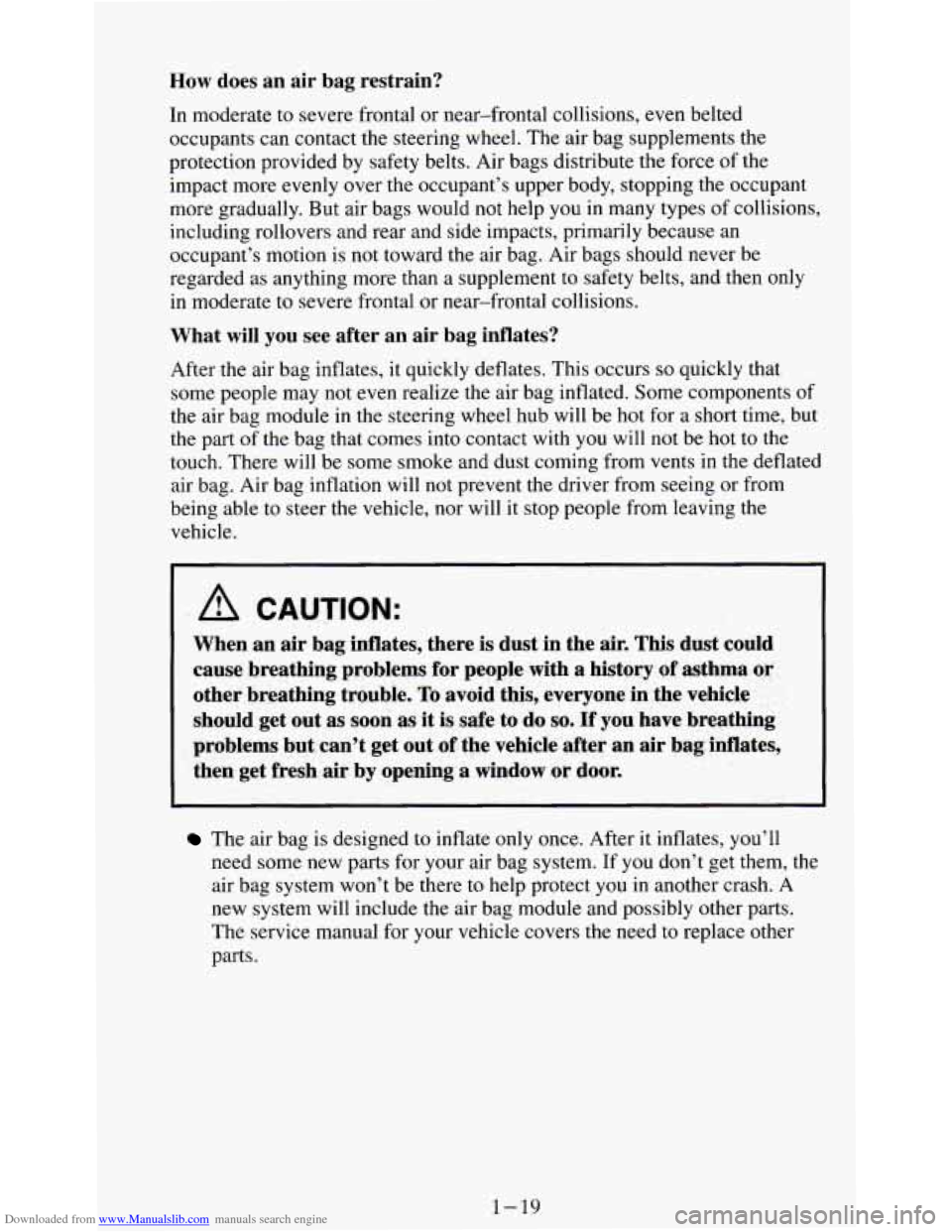
Downloaded from www.Manualslib.com manuals search engine How does an air bag restrain?
In moderate to severe frontal or near-frontal collisions, even belted
occupants can contact the steering wheel. The air bag supplements the
protection provided by safety belts. Air bags distribute the force of the
impact more evenly over the occupant’s upper body, stopping the occupant
more gradually. But air bags would
not help you in many types of collisions,
including rollovers and rear and side impacts, primarily because an
occupant’s motion is not toward the air bag. Air bags should never be
regarded as anything more than a supplement
to safety belts, and then only
in moderate to severe frontal or near-frontal collisions.
What will you see after an air bag inflates?
After the air bag inflates, it quickly deflates. This occurs so quickly that
some people may not even realize the air bag inflated. Some components
of
the air bag module in the steering wheel hub will be hot for a short time, but
the part
of the bag that comes into contact with you will not be hot to the
touch. There will be some smoke and dust coming from vents in the deflated
air bag. Air bag inflation will not prevent
the driver from seeing or from
being able
to steer the vehicle, nor will it stop people from leaving the
vehicle.
A CAUTION:
When an air bag inflates, there is dust in the air. This dust could
cause breathing problems for people with a history
of asthma or
other breathing trouble. To avoid this, everyone in the vehicle
should get out as soon as it is safe to do
so. If you have breathing
problems but can’t get out
of the vehicle after an air bag inflates,
then get fresh air by opening a window or door.
The air bag is designed to inflate only once. After it inflates, you’ll
need some new parts for your air bag system. If you don’t get them, the
air bag system won’t be there to help protect you in another crash. A
new system will include the air bag module and possibly other parts.
The service manual for your vehicle covers the need to replace other
parts.
1-19
Page 42 of 354
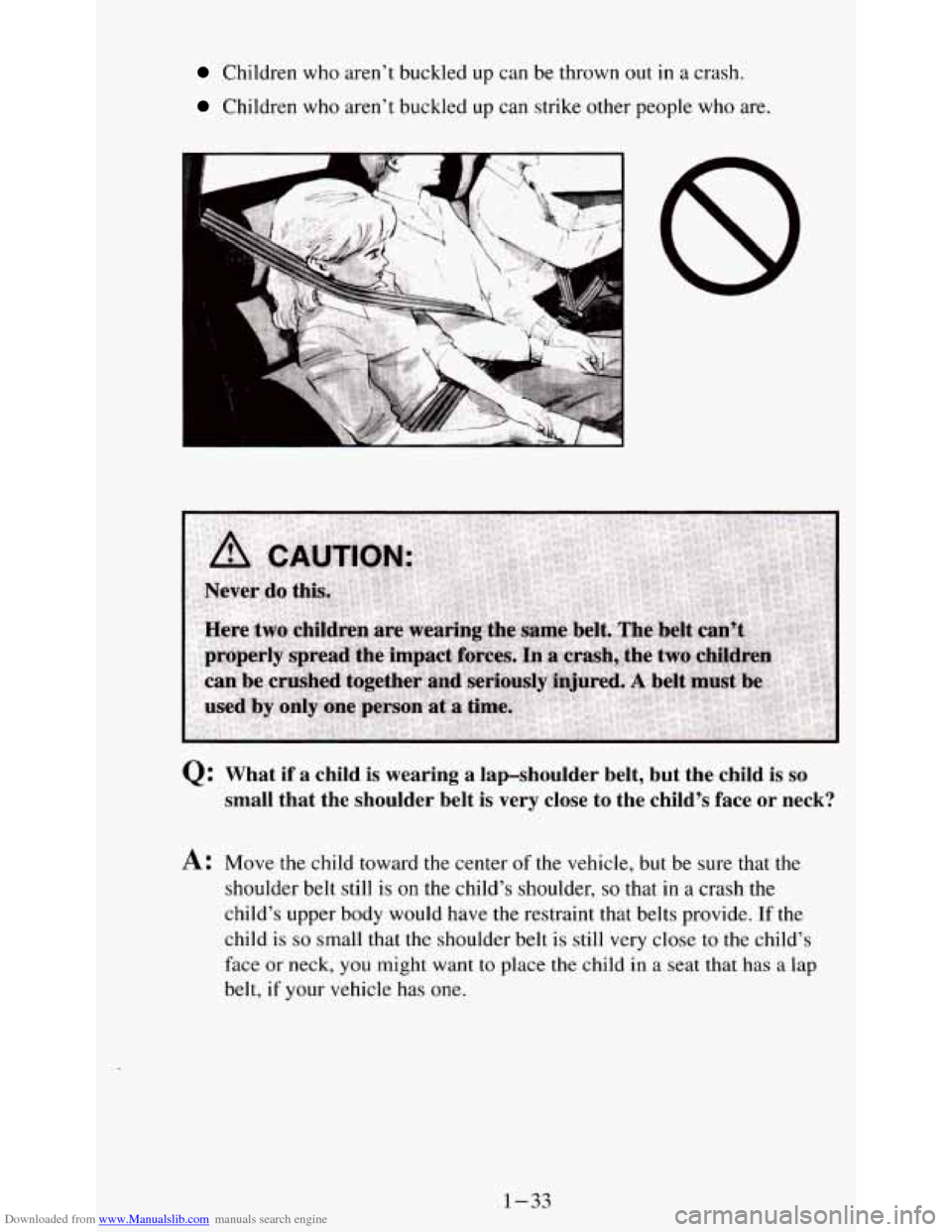
Downloaded from www.Manualslib.com manuals search engine Children who aren’t buckled up can be throWfl Out in a crasn.
Children who aren’t buckled up can strike other people who are.
Q: What if a child is wearing a lap-shoulder belt, but the child is so
small that the shoulder belt is very close to the child’s face or neck?
A: Move the child toward the center of the vehicle, but be sure that the
shoulder belt still is
on the child’s shoulder, so that in a crash the
child’s upper body would have the restraint that belts provide.
If the
child
is so small that the shoulder belt is still very close to the child’s
face
or neck, you might want to place the child in a seat that has a lap
belt, if your vehicle has
one.
1-33
Page 48 of 354
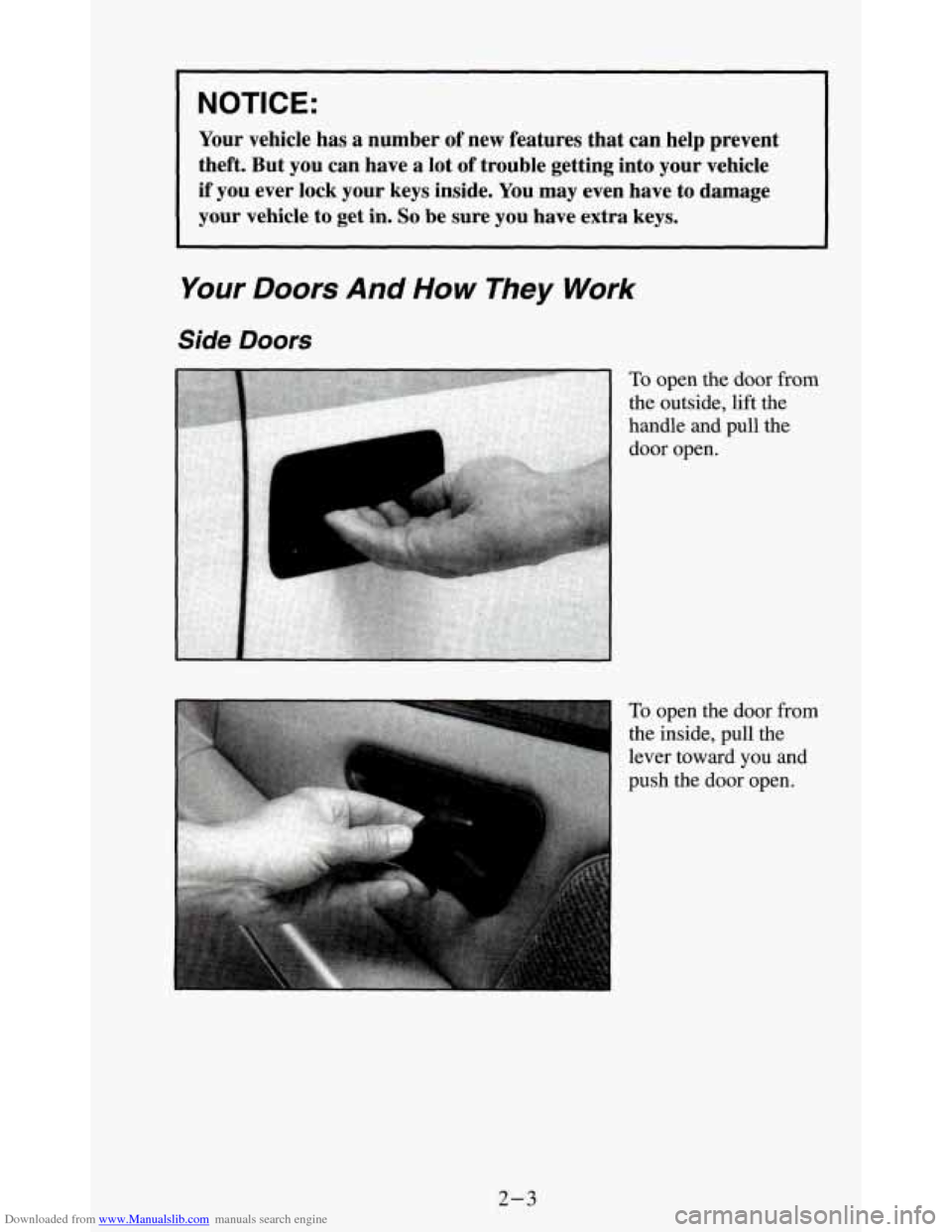
Downloaded from www.Manualslib.com manuals search engine I NOTICE:
Your vehicle has a number of new features that can help prevent
theft. But you can have a lot
of trouble getting into your vehicle
if you ever lock your keys inside. You may even have to damage
your vehicle to get in.
So be sure you have extra keys.
Your Doors And How They Work
Side Doors
To open the door from
the outside, lift the
handle and pull the
door open.
To open the door from
the inside, pull the
lever toward
you and
push the
door open.
2-3
Page 54 of 354

Downloaded from www.Manualslib.com manuals search engine Parking at Nlght
Park in a lighted spot, close all windows and lock your vehicle. Remember
to keep your valuables out
of sight. Put them in a storage area, or take them
with you.
Parking Lots
If you park in a lot where someone will be watching your vehicle, it’s best
to lock
it up and take your keys. But what if you have to leave your ignition
key? What
if you have to leave something valuable in your vehicle?
Put your valuables in a storage area, like your glove box.
Lock all the doors except the driver’s.
New Vehicle “Break-In”
NOTICE:
Your modern vehicle doesn’t need an elaborate “break-in.” But
it will perform better in the long run if you follow these
guidelines:
0 Keep your speed at 55 mph (88 km/h) or less for the first 500
miles (804 km).
Don’t drive at any one speed - fast or slow - for the first
500 miles (804 km). Don’t make full-throttle starts.
Avoid making hard stops for the first 200 miles (322 km) or
so. During this time your new brake linings aren’t yet broken
in. Hard stops with new linings can mean premature wear and
earlier replacement. Follow this “breaking-in” guideline
every time you get new brake linings.
Don’t tow a trailer during “break-in.” See “Towing a Trailer”
in the Index for more information.
2-9
Page 55 of 354
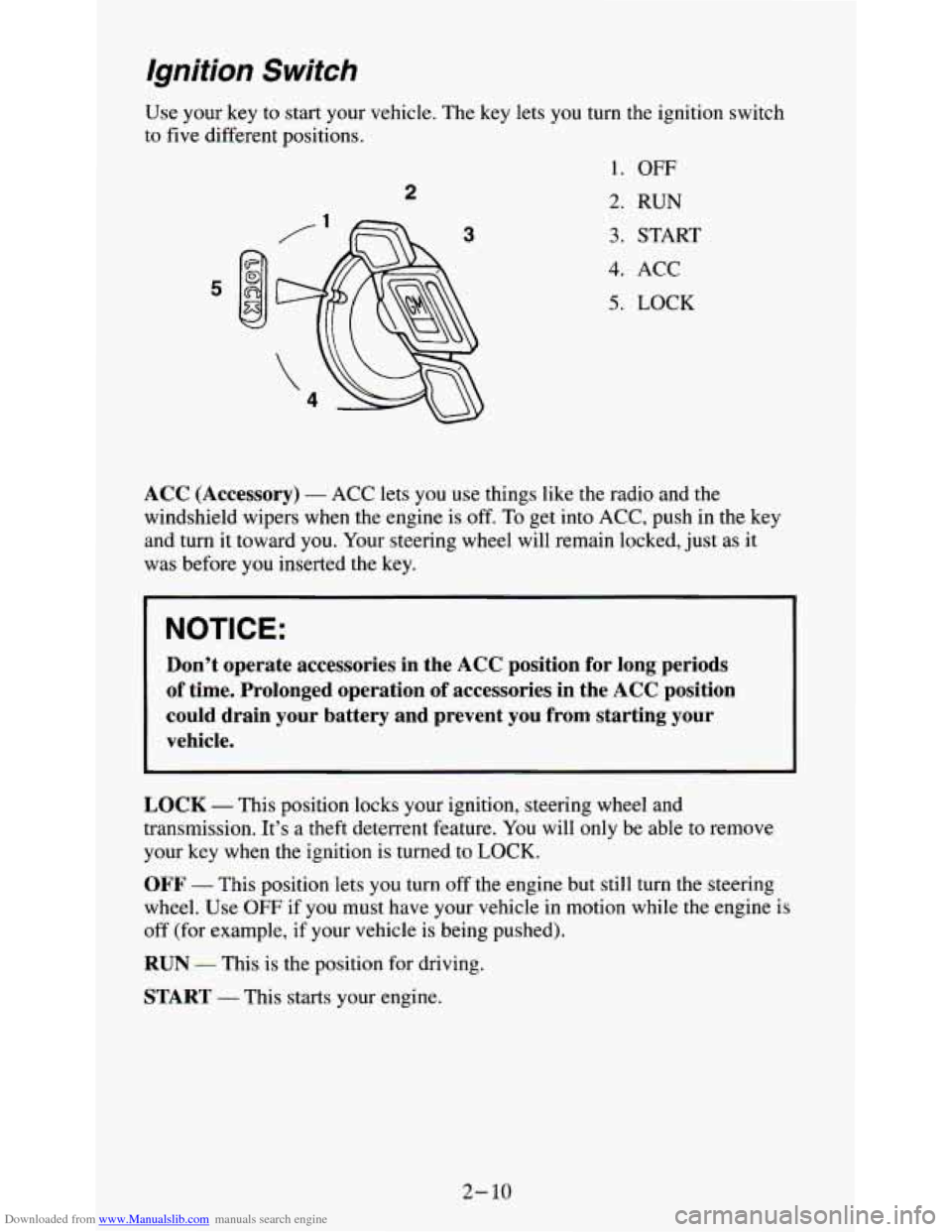
Downloaded from www.Manualslib.com manuals search engine Ignition Switch
2
Use your key to start your vehicle. The key lets you turn the ignition switch
to five different positions.
1.
OFF
2. RUN
3. START
4. ACC
5. LOCK 5
ACC (Accessory) - ACC lets you use things like the radio and the
windshield wipers when the engine is off. To get into ACC, push in the key
and turn it toward
you. Your steering wheel will remain locked, just as it
was before you inserted the key.
Don’t operate accessories in the ACC position for long periods
of time. Prolonged operation
of accessories in the ACC position
could drain your battery and prevent you from starting your
vehicle.
LOCK - This position locks your ignition, steering wheel and
transmission. It’s a theft deterrent feature. You will only
be able to remove
your key when
the ignition is turned to LOCK.
OFF - This position lets you turn off the engine but still turn the steering
wheel. Use
OFF if you must have your vehicle in motion while the engine is
off (for example, if your vehicle
is being pushed).
RUN - This is the position for driving.
START - This starts your engine.
2- 10
Page 58 of 354

Downloaded from www.Manualslib.com manuals search engine 2. If your engine still won’t start (or starts but then stops), it could be
flooded with too much gasoline. Try pushing your accelerator pedal all
the way to the floor and holding it there as you hold the key in START
again, do the same thing, but this time keep the pedal down for five or
six seconds. This clears the extra gasoline from the engine.
’ for about three seconds. If the vehicle starts briefly but then stops
NOTICE:
Your engine is designed to work with the electronics in your
vehicle.
If you add electrical parts or accessories, you could
change the way the fuel injection system operates. Before adding
electrical equipment, check with your dealer.
If you don’t, your
engine might not perform properly.
If you ever have to have your vehicle towed, see the part of this
manual that tells how
to do it without damaging your vehicle.
See “Towing Your Vehicle” in the Index.
To start your 4.3 Liter Code Z engine:
1. Without pushing the accelerator pedal, turn your ignition key to
START. When the engine starts, let go of the key. The idle speed will
go down as your engine gets warm.
NOTICE:
Holding your key in START for longer than 15 seconds at a time
will cause your battery to be drained much sooner. And the
excessive heat can damage your starter motor.
2. If it doesn’t start right away, hold your key in START. If it doesn’t start
in three seconds, push the accelerator pedal about one-quarter of the
way down for 12 more seconds, or until it starts.
3. If your engine still won’t start (or starts but then stops), it could be
flooded with too much gasoline. Try this:
4. Wait 15 seconds to let the starter motor cool down. Then push your
accelerator pedal all the way to the floor. Hold
it there. Then, hold the
key in
START for no more than ten seconds. This clears the extra
gasoline from the engine.
If the engine still doesn’t start, wait another 15 seconds and do Step 4
again.
When the engine starts, let go
of the key and the accelerator pedal.
2-
13